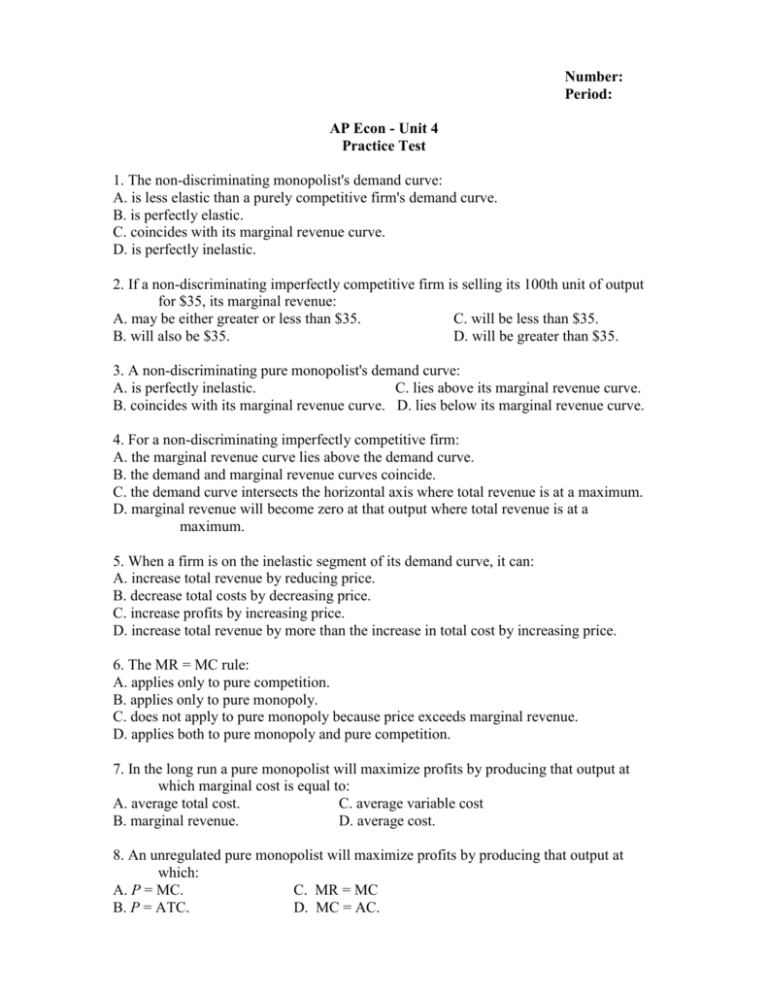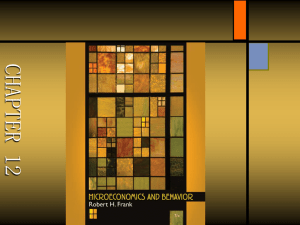AP Econ - Unit 4
advertisement

Number: Period: AP Econ - Unit 4 Practice Test 1. The non-discriminating monopolist's demand curve: A. is less elastic than a purely competitive firm's demand curve. B. is perfectly elastic. C. coincides with its marginal revenue curve. D. is perfectly inelastic. 2. If a non-discriminating imperfectly competitive firm is selling its 100th unit of output for $35, its marginal revenue: A. may be either greater or less than $35. C. will be less than $35. B. will also be $35. D. will be greater than $35. 3. A non-discriminating pure monopolist's demand curve: A. is perfectly inelastic. C. lies above its marginal revenue curve. B. coincides with its marginal revenue curve. D. lies below its marginal revenue curve. 4. For a non-discriminating imperfectly competitive firm: A. the marginal revenue curve lies above the demand curve. B. the demand and marginal revenue curves coincide. C. the demand curve intersects the horizontal axis where total revenue is at a maximum. D. marginal revenue will become zero at that output where total revenue is at a maximum. 5. When a firm is on the inelastic segment of its demand curve, it can: A. increase total revenue by reducing price. B. decrease total costs by decreasing price. C. increase profits by increasing price. D. increase total revenue by more than the increase in total cost by increasing price. 6. The MR = MC rule: A. applies only to pure competition. B. applies only to pure monopoly. C. does not apply to pure monopoly because price exceeds marginal revenue. D. applies both to pure monopoly and pure competition. 7. In the long run a pure monopolist will maximize profits by producing that output at which marginal cost is equal to: A. average total cost. C. average variable cost B. marginal revenue. D. average cost. 8. An unregulated pure monopolist will maximize profits by producing that output at which: A. P = MC. C. MR = MC B. P = ATC. D. MC = AC. 9. Economic profit in the long-run is: A. possible for both a pure monopoly and a pure competitor. B. possible for a pure monopoly, but not for a pure competitor. C. impossible for both a pure monopolist and a pure competitor. D. only possible when barriers to entry are nonexistent. 10. Which of the following statements is correct? A. The pure monopolist will maximize profit by producing at that point on the demand curve where elasticity is zero. B. In seeking the profit-maximizing output, the pure monopolist underallocates resources to its production. C. The pure monopolist maximizes profits by producing that output at which the differential between price and average cost is the greatest. D. Purely monopolistic sellers earn only normal profits in the long run. 11. A single-price pure monopoly is economically inefficient: A. only because it produces beyond the point of minimum average total cost. B. only because it produces short of the point of minimum average total cost. C. because it produces short of minimum average cost and price is greater than marginal cost. D. because it produces beyond minimum average total cost and marginal cost is greater than price. Use the following to answer questions 12 - 17: 12. Refer to the above diagram. Diagram (A) represents: A. equilibrium price and quantity in a purely competitive industry. B. the pure monopoly model. C. an industry in which there is productive efficiency but not allocative efficiency. D. a single firm operating in a purely competitive industry. 13. Refer to the above diagram. Diagram (B) represents: A. the pure competition model. B. an industry in which there is allocative efficiency but not productive efficiency. C. the pure monopoly model. D. a long-run constant-cost industry. 14. Refer to the above diagram. In diagram (B) the profit-maximizing quantity is: A. g and the profit-maximizing price is e. C. g and the profit-maximizing price is f. B. h and the profit-maximizing price is e. D. g and the profit-maximizing price is d. 15. Refer to the above diagram. With the industry structure represented by diagram: A. (A) there will be only a normal profit in the long run, while in (B) an economic profit can persist. B. (A) price exceeds marginal cost, resulting in allocative inefficiency. C. (B) price equals marginal cost, resulting in allocative efficiency. D. (B) equilibrium price and quantity will be e and h, respectively. 16. Refer to the above diagram. With the industry structure represented by diagram: A. (A) there will be allocative inefficiency. C. (B) output will be less than in diagram (A). B. (A) economic profit can persist in the long run. D. (B) output will be the same as in Diagram (A). 17. Refer to the above diagram. The price will be _______ and the quantity will be _______ with the industry structure represented by diagram (B) compared to the one reprsented in (A). A. higher; higher. C. lower, lower B. higher, lower. D. lower, higher. 18. If a monopolist engages in price discrimination, we can expect: A. profits to increase and output to fall. B. both profits and output to increase. C. both profits and output to decrease. D. the demand curve to lie below the marginal revenue curve. 19. The practice of price discrimination is associated with pure monopoly because: A. it can be practiced whenever a firm's demand curve is downsloping. B. monopolists have considerable ability to control output and price. C. monopolists usually realize economies of scale. D. most monopolists sell differentiated products. Use the following to answer questions 20 - 21: 20. Refer to the above diagram for a pure monopolist. If the monopolist is unregulated, it will maximize profits by charging: A. a price above P3 and selling a quantity less than Q3. B. price P3 and producing output Q3. C. price P2 and producing output Q2. D. price P1 and producing output Q1. 21. Refer to the above diagram for a pure monopolist. Suppose a regulatory commission is created to determine a legal price for the monopoly. If the commission seeks to provide the monopolist with a "fair return," it will set price at: A. P1. C. P2. B. P3. D. P4. 22. Refer to the above diagram for a pure monopolist. If a regulatory commission seeks to achieve the most efficient allocation of resources to this line of production, it will set a price of: A. P1. C. P2. B. P3. D. P4.








